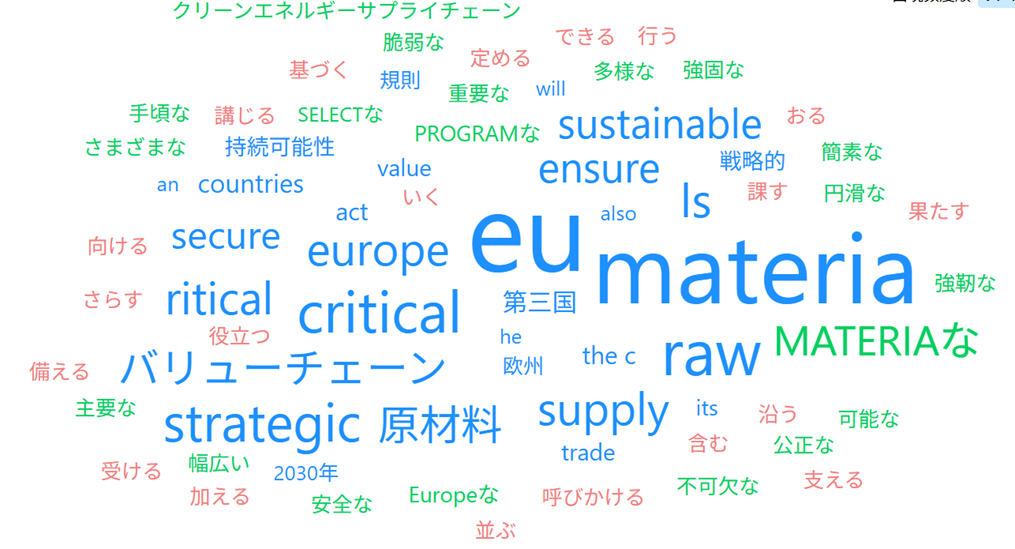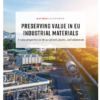欧州Critical Raw Materials Act2024 暫定訳と本文
2024年4月11日に欧州議会で定められた欧州Critical Raw Materials Actの暫定訳と本文のテキストです。
欧州Critical Raw Materials Actは2020に定められたcritical raw allianceを近年の資源を巡る状況の変化に合わせて改訂したもので、リサイクル目標を15%から25%に引き上げるなど、欧州域ないの生産を重視しており、サーキュラーエコノミーにも大きな影響を与える内容をふくんでいます。
• EUの年間消費量の少なくとも10%を抽出に利用
• EUの年間消費量の少なくとも40%を加工に使用
• EUの年間消費量の少なくとも25%をリサイクルに充てる
• EUの年間消費量の65%以下を単一の第三国から輸入すること

Critical Raw Materials Act
文書32024R1252
2024年4月11日の欧州議会および理事会の規則(EU)2024/1252は、重要な原材料の安全かつ持続可能な供給を確保するための枠組みを確立し、規則(EU)No 168/2013、(EU)2018/858、(EU)2018/1724、および(EU)2019/1020を改正するものです(EEAに関連するテキスト)
重要原材料は、EU 経済にとって不可欠であり、再生可能エネルギー、デジタル、航空宇宙、防衛などの戦略的セクターに必要な幅広い技術です。重要原材料法 (CRM 法) は、EU が重要原材料の安全で持続可能な供給にアクセスできるようにし、ヨーロッパが 2030 年の気候およびデジタル目標を達成できるようにします。
重要原材料法の概要
重要原材料は欧州にとって経済的に非常に重要である一方で、供給途絶に対して非常に脆弱です。重要原材料は、経済の脱炭素化を背景に世界的な需要増加に直面しています。例えば、EUにおける希土類金属の需要は2030年までに6倍、2050年までに7倍に増加すると予想されており、リチウムについては、EUの需要は2030年までに12倍、2050年までに21倍に増加すると予想されています。今日、欧州は輸入に大きく依存しており、その多くは単一の第三国からの輸入です。近年の危機は、EUの戦略的依存を浮き彫りにしました。共同でタイムリーな行動、円滑に機能する単一市場、回復力、競争力がなければ、欧州の産業と
EUの気候変動対策およびデジタル目標達成に向けた取り組みは危険にさらされます。
欧州重要原材料法は、これらの課題に対する包括的な対応策です。単一市場の強みを基盤として、本法案は、EUが重要原材料の強固で、回復力があり、持続可能なバリューチェーンに依存できるようにします。本規則は、欧州の重要原材料バリューチェーンのあらゆる段階を強化し、EUの輸入を多様化することで戦略的依存を軽減し、重要原材料の供給途絶リスクを監視・軽減するEUの能力を向上させ、循環性と持続可能性を向上させます。
本規則に付随するコミュニケーションでは、EUが信頼できるパートナーとの投資、生産、貿易の発展と多様化に向けた世界的な取り組みをどのように強化していくかが概説されています。EUは、第三国と互恵的なパートナーシップを通じて協力し、これらの目標を追求していきます。その目的は、第三国自身の持続可能な経済発展を促進すると同時に、EUにとって安全で、強靭で、手頃な価格で、十分に多様化されたバリューチェーンを構築することです。
グリーンディール産業計画に沿って、重要原材料法は、クリーンエネルギーサプライチェーンのための主要なカーボンニュートラル技術の製造拡大を目的とした欧州委員会のネットゼロ産業法と並行して制定される。
重要原材料法に基づく措置
行動の優先順位を設定する
EU経済全体にとって重要な原材料の最新リストに加え、グリーン、デジタル、防衛、航空宇宙の用途に使用される戦略的技術にとって最も重要な 戦略的原材料もリストアップしています。
2030年までに国内生産能力のベンチマークを設定
この法律は、戦略的原材料バリューチェーンに沿って、またEUの供給の多様化のためにこれらのベンチマークを設定する。
• EUの年間消費量の少なくとも10%を抽出に利用
• EUの年間消費量の少なくとも40%を加工に使用
• EUの年間消費量の少なくとも25%をリサイクルに充てる
• EUの年間消費量の65%以下を単一の第三国から輸入すること
安全で回復力のあるサプライチェーンの構築
この法律は、EUにおける重要な原材料プロジェクトの許可手続きを簡素化し、行政負担を軽減するとともに、高い社会的・環境的保護の維持を確保します。さらに、選定された戦略的プロジェクトは、資金へのアクセス支援と許可期間の短縮(採掘許可は27ヶ月、加工・リサイクル許可は15ヶ月)の恩恵を受ける。EU加盟国は、地質資源探査のための国家プログラムを策定する必要もある。
供給リスクへの備えと軽減
サプライチェーンの回復力を確保するため、この法律は重要な原材料のサプライチェーンの監視とストレステストを実施し、戦略的在庫を調整し、戦略的技術を生産する大企業にリスク準備義務を課します。
EU市場における重要な原材料の持続可能性と循環性の向上
EU 諸国は、重要原材料を多く含む廃棄物の収集を改善し、二次重要原材料へのリサイクルを確実にするための措置を講じます。EU 諸国と民間事業者は、抽出廃棄物から重要原材料を回収する可能性を調査する必要があります。永久磁石の大規模なリサイクルを奨励するため、この法律ではリサイクル性とリサイクル内容に関する要件を定めています。この法律により、委員会はさまざまなセーフガードの対象となる重要原材料の環境フットプリントに関する規則を制定できます。これにより、EU 市場に投入される重要原材料の循環性と持続可能性が向上し、顧客が重要原材料を含む製品について十分な情報に基づいて選択できるようになります。
欧州連合の原材料輸入の多様化
国際貿易は世界の生産を支え、供給の多様化を確保する鍵となる。EUの行動には以下が含まれる。
• 貿易協定を利用して重要な原材料の貿易を確保し、多様化を図る
• バリューチェーンアプローチと強力な持続可能性の側面を備えたEUの戦略的パートナーシップのネットワークを拡大する
• ソフトおよびハードインフラのグローバルゲートウェイを使用して、原材料バリューチェーンに沿ったプロジェクトを展開し、接続性をサポートします。
• 海外投資のリスクを低減するためにEU諸国と協力してEU輸出信用制度を設立する
• 原材料に関する不公正な貿易慣行に対処し、執行を強化する
全体的な調整を確実にするために、この法律では、EU諸国と委員会から構成され、この法律で定められた措置の実施について助言や調整を行い、第三国とのEUの戦略的パートナーシップについて議論する欧州重要原材料委員会の設置を提案している。
背景
フォンデアライエン大統領は2022年の一般教書演説で重要原材料法を発表した。 演説では、EUの輸入原材料への依存に対処するため、国内の重要原材料の供給を多様化し、持続可能な形で確保するよう呼びかけた。この演説は、 2022年のヴェルサイユ宣言に対応したものである。欧州理事会が採択した「重要原材料戦略」は、 EUの戦略的自立と欧州の主権を保障する上で、重要原材料の戦略的重要性を概説しています。また、この戦略は、欧州の未来に関する会議の結論、そして2021年11月に欧州議会が採択したEU重要原材料戦略に関する決議にも対応しています。
欧州委員会域内市場・産業・企業家精神・中小企業総局は、欧州における重要原材料(CRM)の持続可能な供給と利用の促進において重要な役割を果たしています。同総局は、EU原材料イニシアチブと並んで、重要原材料法の施行を担当しています。
および2020年重要原材料行動計画を策定しました。同局は、重要度評価と将来予測レポートも担当しています。
重要原材料法は グリーンディール産業計画の一部であるEUのネットゼロ産業法と並行して提出された重要原材料法は、EUの気候とエネルギーに関する目標を達成するために、クリーンエネルギーの安全で持続可能かつ競争力のあるサプライチェーンを確保するために、主要なカーボンニュートラルまたは「ネットゼロ」技術のEUでの製造を拡大するのに役立ちます。
欧州委員会は2011年から原材料の重要性を評価しており、それ以来3年ごとにEU重要原材料リストの最新版を公表しています。2023年には、87の原材料について、供給リスクとEU経済にとっての重要性について分析が行われました。評価結果は、ある研究で発表されています。、そして ファクトシートには、選別された各材料に関する詳細情報が記載されています。また、この報告書には、原材料に関する最新の予測調査も添付されています。。
関連リンク
• 規制
• コミュニケーション
• ファクトシート
• 質疑応答
• CRMA提案に関するプレスリリース(2023年)
• CRMA導入に関するプレスリリース(2024年)
• CRMAページの戦略プロジェクト
文書
影響評価
• 影響評価
• パブリックコンサルテーションの概要
関連コンテンツ
• ファクトシート
• CRMウェブページ
• グリーンディール産業計画ページ
Critical Raw Materials are indispensable for the EU economy and a wide set of necessary technologies for strategic sectors such as renewable energy, digital, aerospace and defence. The Critical Raw Materials Act (CRM Act) will ensure EU access to a secure and sustainable supply of critical raw materials, enabling Europe to meet its 2030 climate and digital objectives.
Overview of the Critical Raw Materials Act
Critical raw materials are of high economic importance for Europe while being also highly vulnerable to supply disruptions. Critical raw materials are confronted with a growing global demand, driven by the decarbonisation of economies. For instance, EU demand for rare earth metals is expected to increase six-fold by 2030 and seven-fold by 2050, for lithium, EU demand is expected to increase twelve-fold by 2030 and twenty-one-fold by 2050. Today, Europe relies heavily on imports, often from a single third country, and recent crises have underlined EU strategic dependencies. Without joint and timely action, a well-functioning single market, resiliency and competitiveness, European industries and
EU efforts to meet its climate and digital objectives are at risk.
The European Critical Raw Materials Act is a comprehensive response to these challenges. Building on the strength of the single market, the Act will ensure that the EU can rely on strong, resilient, and sustainable value chains for critical raw materials. The Regulation will strengthen all stages of the European critical raw materials value chain, diversify the EU’s imports to reduce strategic dependencies, improve EU capacity to monitor and mitigate risks of disruptions to the supply of critical raw materials, and improve circularity and sustainability.
A communication accompanying the Regulation outlines how the EU intends to strengthen its global engagement to develop and diversify investment, production, and trade with reliable partners. The EU will pursue these objectives in cooperation with third countries through mutually beneficial partnerships, with a view to promoting their own economic development in a sustainable manner while also creating secure, resilient, affordable and sufficiently diversified value chains for the EU.
In line with the Green Deal Industrial Plan, the Critical Raw Materials Act comes out alongside the Commission’s Net Zero Industry Act, which aims to scale up the manufacture of key carbon-neutral technologies for clean energy supply chains.
Actions under the Critical Raw Materials Act
Setting priorities for action
In addition to an updated list of critical raw materials for the whole EU economy, it lists strategic raw materials, which are those most crucial for strategic technologies used for the green, digital, defence and aerospace applications.
Setting benchmarks by 2030 for domestic capacities
The Act sets these benchmarks along the strategic raw materials value chain and for the diversification of the EU supplies
• at least 10% of the EU’s annual consumption for extraction
• at least 40% of the EU’s annual consumption for processing
• at least 25% of the EU’s annual consumption for recycling
• no more than 65% of the EU’s annual consumption from a single third country
Creating secure and resilient supply chains
The Act will reduce the administrative burden, streamlining permitting procedures for critical raw materials projects in the EU while ensuring that we keep high social and environmental protection. In addition, selected strategic projects will benefit from support for access to finance and shorter permitting timeframes (27 months for extraction permits and 15 months for processing and recycling permits). EU countries will also have to develop national programmes for exploring geological resources.
Supply risk preparedness and mitigation
To ensure supply chain resilience, the Act creates critical raw materials supply chain monitoring and stress-testing, coordinates strategic stocks and sets risk preparedness obligation on large companies producing strategic technologies.
Improving sustainability and circularity of critical raw materials on the EU market
EU countries will take measures to improve the collection of critical raw material-rich waste and ensure its recycling into secondary critical raw materials. EU countries and private operators will have to investigate the potential for recovery of critical raw materials from extractive waste. To incentivise large-scale recycling of permanent magnets, the Act sets requirements on recyclability and recycled content. The Act empowers the Commission to establish rules for the environmental footprint of critical raw materials subject to various safeguards. This will help to increase the circularity and sustainability of critical raw materials placed on the EU market, allowing customers to make informed choices about products containing critical raw materials.
Diversifying the Union’s imports of raw materials
International trade is key to supporting global production and ensuring the diversification of supply. EU actions include
• using trade agreements to secure and diversify trade in critical raw materials
• expanding the EU’s network of strategic partnerships with a value chain approach and strong sustainability dimension
• using the Global Gateway for soft and hard infrastructure to deploy projects along the raw materials value chain and support connectivity
• working with EU countries to set up an EU export credit facility to low the risk of investment abroad
• tackling unfair trade practices related to raw materials and increasing enforcement
To ensure overall coordination, the act proposes a European Critical Raw Materials Board, composed of EU countries and the Commission to advise on and coordinate the implementation of the measures set out in the act and discuss the EU’s strategic partnerships with third countries.
Background
President von der Leyen announced the Critical Raw Materials Act during her 2022 State of the Union speech, calling to address EU dependency on imported critical raw materials by diversifying and securing a domestic and sustainable supply of critical raw materials. The speech responds to the 2022 Versailles Declaration, adopted by the European Council, which outlined the strategic importance of critical raw materials to guarantee the Union’s strategic autonomy and European sovereignty. It also responds to the conclusions of the Conference on the Future of Europe and to the November 2021 resolution of the European Parliament for an EU critical raw materials strategy.
The European Commission’s Directorate-General for Internal Market, Industry, Entrepreneurship and SMEs plays a vital role in promoting the sustainable supply and use of critical raw materials (CRMs) in Europe. The Directorate-General is responsible for implementing the Critical Raw Materials Act, alongside the EU Raw Materials Initiative
and the 2020 Action Plan on Critical Raw Materials. The Directorate is also responsible for the criticality assessment and the foresight report.
The Critical Raw Material Act is part of the Green Deal Industrial Plan. Presented in parallel with the EU’s Net Zero Industry Act, the Critical Raw Materials Act will help to scale up the EU manufacture of key carbon neutral or ‘net-zero’ technologies to ensure a secure, sustainable and competitive supply chain for clean energy to reach the EU’s climate and energy ambitions.
The Commission has been assessing raw materials for their criticality since 2011. Since then, it has published an update of the list of EU Critical Raw Materials every three years. In 2023, 87 materials were analysed for their supply risk and importance to the EU economy. See the results of the assessment published in a study, and detailed information on each screened material in its factsheet. Accompanying this work is also the updated foresight study on raw materials.





ディスカッション
コメント一覧
まだ、コメントがありません